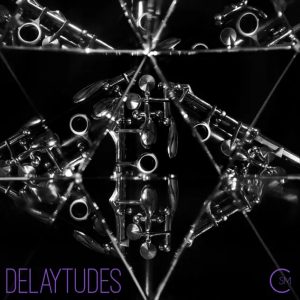
TCO Audio Reviews: November 2025
Karl Kolbeck, Audio Review Editor
Natalie Szabo, Associate Audio Review Editor, TCO
 Delaytudes. Christopher Mothersole, clarinet and delay. C. Mothersole: Delaytudes, No. 1: Brisk; Delaytudes, No. 2: Tranquil; Delaytudes, No. 3: Incisive; Delaytudes, No. 4: Gently Meandering, with Rubato; Delaytudes, No. 5: Vivacious; Delaytudes, No. 6: Flamboyant Funk; Delaytudes, No. 7: Quick and Light-Footed; Delaytudes, No. 8: Brumous; Delaytudes, No. 9: Frolicking; Delaytudes, No. 10: Chasing. Independent Release. Available on streaming platforms. Total time: 20:29.
Delaytudes. Christopher Mothersole, clarinet and delay. C. Mothersole: Delaytudes, No. 1: Brisk; Delaytudes, No. 2: Tranquil; Delaytudes, No. 3: Incisive; Delaytudes, No. 4: Gently Meandering, with Rubato; Delaytudes, No. 5: Vivacious; Delaytudes, No. 6: Flamboyant Funk; Delaytudes, No. 7: Quick and Light-Footed; Delaytudes, No. 8: Brumous; Delaytudes, No. 9: Frolicking; Delaytudes, No. 10: Chasing. Independent Release. Available on streaming platforms. Total time: 20:29.
In his 2024 album, Delaytudes, Christopher Mothersole presents 10 original etudes for clarinet and live audio delay, calling it “clarinet with a twist.” Each piece is intended to challenge the performer in a different way, whether it be their sense of time, intonation, or dynamic consistency, and introduce them to playing with a delay. In Mothersole’s presentation of the etudes, he demonstrates impressive technicality, fluidity and consistency across the range of the instrument, expert timing and control, and a beautiful, warm tone.
The album begins with a video recording of Mothersole performing Brisk, along with scrolling excerpts from the score and a description of the album and first etude. This etude’s challenge is timing, and Mothersole’s skillful playing and strong sense of pulse resulted in perfect alignment with the delay. This combined with his smooth tone created a feeling of constant forward flow. Tranquil featured strong dynamic contrast and percussive offbeat echoes that created glimmers of energy above the rippling texture. Incisive is quick and staccato, with articulation precision required to accurately align with the delay. The album’s highlight was Brumous, defined as foggy and wintry. Inspired by Beethoven and Saint-Saëns, this etude features dark, legato lines with occasional high staccatissimo notes and timbral trills which adds gentle gleams of light.
It is clear from both his skillful artistry on this album and his composition of these etudes that Mothersole is truly an expert and a visionary in the realm of classical clarinet playing using guitar effects pedals. He is not only dedicated to the expansion and exploration of this medium, but to making it accessible to newcomers. This album is refreshing and original and I highly recommend it to anyone interested in the future possibilities for classical clarinet playing.
– Sarah Korneisel Jaegers
 bee sage. Fie Schouten, clarinet; Katharina Gross, cello. K. Saariaho: Oi kuu. D. Rotaru: Masks. R. Hirs: bee sage. T. Tüzün: Dyssynchrony. D. Andrikopoulos: “When you see…”. Attacca, AT2024171. Total Time: 59:47.
bee sage. Fie Schouten, clarinet; Katharina Gross, cello. K. Saariaho: Oi kuu. D. Rotaru: Masks. R. Hirs: bee sage. T. Tüzün: Dyssynchrony. D. Andrikopoulos: “When you see…”. Attacca, AT2024171. Total Time: 59:47.
In bee sage, performers Fie Schouten and Katharina Gross offer a masterclass in sonic exploration, drawing the listener into a rich and varied sound world. This album showcases the versatility and expressive depth of the cello and clarinet with unwavering control and deep musical insight. Schouten and Gross not only meet the formidable technical demands of this repertoire, but transcend them, offering interpretations that are emotionally resonant, intellectually compelling, and artistically unified.
Oi Kuu (1990) by Kaija Saariaho, which translates to “Oh moon” is a work that has a truly unique tapestry of sound. The composer writes that the harmony is based on the multiphonics of the clarinet and the cello and explores a wide variety of timbral variations. This work is indicative to the spectral style Saariaho has become well known for composing and the variety of colors and textures is captured beautifully by Schouten and Gross. Both have total mastery of their instruments, and their extreme control of the extended techniques is remarkable. It’s difficult to imagine how this work could be performed better than this.
Doina Rotaru’s Masks (1989/2024) is organized conceptually in the style of four distinct sections that each represent imaginary masks. Each section is marked by a gong, which makes the sections quite clear, in addition to each section being so different from one another. The compositional material is interesting and lives in a sound world that explores playing these instruments in a way outside of the classical tradition. That said, both performers are the prime definition of elite artists as they use these sounds to create a composite that is interesting and effective.
bee sage by Rozalie Hirs (2023), is named after the plant native to the southwestern United States. The work draws compositional inspiration from the use of plants in rituals centered around purification, healing and spiritual practices. The composer writes that the cello part uses different tones with the resonance of the contrabass clarinet revealing the fundamental frequencies in the harmonic language of the cello. The heart of this style of music can be difficult to capture on recording, but it has certainly been done here. I can only imagine that hearing this live this would be even more stunning. The experience is one where there is a third part created out of the two intertwined parts and the sonic interplay between the voices. The fact that Schouten and Gross have captured that is a testament to their outstanding musicianship and proof that in music the sum is often greater than the parts.
Tolga Tüzün’s Dyssynchrony (2023), is based on short motifs that sometimes align, and other times are completely disjointed. The rhythmic complexity is certainly robust, but there are moments of stillness interspersed. The ability of both performers to seamlessly alternate between intentionally uncoordinated moments and then be totally locked in with each other sounds effortless on this recording. The mastery required to realize this piece is not to be taken for granted.
“When you see…” by Dimitris Andrikopoulos (2023) is not intentionally programmatic, as the composer writes, but instead it seeks to express the tone of the poem below. The idea being a stark opposition to the romanticization of human sacrifice in war. The result is a piece that is desolate and powerful. The performance from Schouten and Gross is filled with depth and meaning. They capture the intentions of the piece so beautifully that to describe it would ruin it. For me, the only way to capture the gravity of this work is to experience it.
When you see millions of the mouthless dead …
Give them not praise.
For, deaf, how should they know …
Nor tears.
Their blind eyes see not your tears flow.
Nor honour.
It is easy to be dead. …
Charles Sorley (1895-1915)
– Spencer Prewitt
 Robert Simpson: Chamber Music, Vol. 1. Peter Cigleris, clarinet; Emma Johnson, clarinet; Derek Hannigan, bass clarinet; Raphael Wallfisch, cello; John Lenehan, piano; Cornelis Witthoefft, piano; Eva-Maria Hartmann, soprano; Will Duerden, double bass; Levi Andreassen, double bass; Daniil Margulis, double bass. R. Simpson: String Quartet in D Major; Trocknet nicht!; The Cherry Tree; Trio for Clarinet, Cello, and Piano; Quintet for Clarinet, Bass Clarinet, and Three Double Basses. Toccata Classics, TOCC 0701. Total Time: 76:06
Robert Simpson: Chamber Music, Vol. 1. Peter Cigleris, clarinet; Emma Johnson, clarinet; Derek Hannigan, bass clarinet; Raphael Wallfisch, cello; John Lenehan, piano; Cornelis Witthoefft, piano; Eva-Maria Hartmann, soprano; Will Duerden, double bass; Levi Andreassen, double bass; Daniil Margulis, double bass. R. Simpson: String Quartet in D Major; Trocknet nicht!; The Cherry Tree; Trio for Clarinet, Cello, and Piano; Quintet for Clarinet, Bass Clarinet, and Three Double Basses. Toccata Classics, TOCC 0701. Total Time: 76:06
This album is the first in a planned two-volume series devoted to the music of Robert Simpson (1921–1997), the English composer, BBC producer, and broadcaster. As described in Matthew Taylor’s detailed liner notes, much of Simpson’s orchestral and chamber output was recorded during his lifetime, though some recordings have since been lost. This release seeks to reintroduce audiences to the distinguished work of a composer whose prolific contributions to chamber music deserve renewed attention.
Simpson composed two inventive chamber works including clarinet featured on this album: the Trio for Clarinet, Cello and Piano (1967), and the Quintet for Clarinet, Bass Clarinet and Three Double Basses (1981). These works are performed with extraordinary skill by three prominent British clarinetists: Emma Johnson in the Trio; as well as Peter Cigleris (clarinet) and Derek Hannigan (bass clarinet) in the Quintet. Simpson’s gift for large-scale instrumental writing shines in the intricate interplay between clarinet and strings in both works.
The Trio opens with high clarinet and low cello, evoking a quality of astronomical spheres which evidently fascinated Simpson throughout his life. As the piano begins to interject the space, the trio soon erupts into vigorous harmonic development, including virtuosic gestures for the clarinet and tremendous dexterity from all performers. Emma Johnson and cellist Raphael Wallfisch approach this intertwined writing with extreme precision throughout the opening and closing movements, while still continuing to have great sensitivity in the spacious development section.
The Quintet opens with an ethereal texture highly unusual in its use of string basses moving in extremely high registers above the clarinet, gradually building a mysterious texture in a completely original and intriguing way. This inversion of instrumental roles contributes to a sense of spatial and harmonic ambiguity. The depth of the string basses richly complements the bass clarinet textures, and both clarinetists complement each other brilliantly in the duo section.
According to the album notes, Simpson held fast to his convictions for the atypical scoring with three string basses, while eventually arranging this work for more traditional string trio ensembles. In either setting, it is a work well worth studying, in addition to the energetic Trio. Both are notable additions to the twentieth century clarinet chamber repertoire.
Further reading about the composer is available via the Robert Simpson Society, an organization dedicated to promoting Simpson’s musical and literary heritage: https://robertsimpson.org.uk/
– Emily Kerski
 Antidogma. David Carter, clarinet; Ricardo Coelho de Souza, percussion; Nelson González Barreto, contrabass; Ilka López, mezzo-soprano; Diana Figueroa, piano; German Dmitriev, violin; Lera Matveeva, viola; Elisey Vasiliev, cello; Nicole Samara Ortiz, soprano; Ernesto Busigó, piano; Katherine Herrero, flute; Camerata Coral de Puerto Rico, Amarilis Pagán-Vila, director; Dave Kemp, percussion; Camila Otero, soprano; Gabrielle Timofeeva, soprano; Amaya Ortiz, soprano; Orquesta Camerata Filarmónica, Emanuel Olivieri, conductor; John Zeff, Samuele Bergamini, piano. W. Ortiz: Rumbeando en la melangolia; Yo fui la más callada; Trio Concertante en 3 Realidades; Nací; Brisa urbanai; Songs of Coconut; Tamboleo; Rito Ceremonial of the Church of the Spanglish Nación; Bombazo. Centaur Records, CRC 4071. Total Time: 65:29.
Antidogma. David Carter, clarinet; Ricardo Coelho de Souza, percussion; Nelson González Barreto, contrabass; Ilka López, mezzo-soprano; Diana Figueroa, piano; German Dmitriev, violin; Lera Matveeva, viola; Elisey Vasiliev, cello; Nicole Samara Ortiz, soprano; Ernesto Busigó, piano; Katherine Herrero, flute; Camerata Coral de Puerto Rico, Amarilis Pagán-Vila, director; Dave Kemp, percussion; Camila Otero, soprano; Gabrielle Timofeeva, soprano; Amaya Ortiz, soprano; Orquesta Camerata Filarmónica, Emanuel Olivieri, conductor; John Zeff, Samuele Bergamini, piano. W. Ortiz: Rumbeando en la melangolia; Yo fui la más callada; Trio Concertante en 3 Realidades; Nací; Brisa urbanai; Songs of Coconut; Tamboleo; Rito Ceremonial of the Church of the Spanglish Nación; Bombazo. Centaur Records, CRC 4071. Total Time: 65:29.
In Antidogma, composer William Ortiz offers a vivid sonic tapestry shaped by a lifelong negotiation of culture, place, and resistance. This 13-track album traverses decades of Ortiz’s compositional voice spanning from jazz-inflected chamber works, experimental vocal pieces, to Afro-Caribbean-infused textures. From the syncopated interplay of clarinet and percussion in Rumbeando en la melangolla to the choral vibrancy of Songs of Coconut, Ortiz constructs an anti-dogmatic aesthetic which is layered, defiant, and resolutely Puerto Rican. The recording underscores Ortiz’s signature blend of social commentary and musical hybridity, which bridges urban New York sounds with Caribbean traditions including ritual, street life, and poetic resistance.
The recording starts with a very prominent clarinet solo in Rumbeando en la melangolla that was accompanied with percussion. Carter does an excellent job in being able to capture the attention of the listener initially. This piece is technically challenging and requires Carter to engage with multiple percussion instruments often in the extreme registers of the instrument. He understands the technical needs needed to emulate the traditional style. I thought it was interesting how the work explored different colors of the percussion instruments with the clarinet at the fore. Carter does a great job of blending with the percussion to create a wide tapestry of colors
Rito Ceremonial of the Church of the Spanglish Nación unfolds as a slow-burning invocation which is gradually layered by the clarinet, percussion, contrabass, and voice into a dissonant, immersive soundscape. William Ortiz-Alvarado challenges the conventions of Western classical form, guiding the listener through shifting sonic terrains that range from subtle textural murmurs to explosive extremes at the edges of each instrument’s register. At once ritualistic and rebellious, the piece weaves in bursts of spoken word that rupture expectations and anchor the work in a cultural-political consciousness. This is music that doesn’t ask for passive hearing, but demands deep, attentive listening.
– Kristine Dizon
 FEMALE. Christoph Pepe Auer, saxophone and clarinet; Stefanie Boltz, vocals; Christian Wegscheider, piano; Jörg Seidel, guitar and vocals; Fany Kammerlander, cello. S. Boltz: Evocation 1: Spiritui sancto honor sit; Help Me; Lullaby of the Leaves; Nobody Knows You When You’re Down and Out; I Wish I Knew How it Would Feel to be Free; Dämm’rung senkte sich von oben; Throw it Away; Evocation 2: I Still Recall; Bessie Smith; Blues for Ma; Ghost of Yesterday; Evocation 3: It’s me, Cathy; Wuthering Heights; Laue Sommernacht; The First of a Million Tears. GLM, FM385-2 Total Time: 46:59.
FEMALE. Christoph Pepe Auer, saxophone and clarinet; Stefanie Boltz, vocals; Christian Wegscheider, piano; Jörg Seidel, guitar and vocals; Fany Kammerlander, cello. S. Boltz: Evocation 1: Spiritui sancto honor sit; Help Me; Lullaby of the Leaves; Nobody Knows You When You’re Down and Out; I Wish I Knew How it Would Feel to be Free; Dämm’rung senkte sich von oben; Throw it Away; Evocation 2: I Still Recall; Bessie Smith; Blues for Ma; Ghost of Yesterday; Evocation 3: It’s me, Cathy; Wuthering Heights; Laue Sommernacht; The First of a Million Tears. GLM, FM385-2 Total Time: 46:59.
To celebrate a milestone birthday, Stefanie Boltz didn’t just throw a party, she built a time-traveling, genre-blurring salon of women’s voices across centuries. FEMALE is the result: an intimate, expansive tribute to the creative force of women in music, curated and performed with striking imagination by the Munich-based singer, songwriter, and storyteller. From Hildegard von Bingen to Kate Bush, from salon composer Fanny Hensel to blues legend Bessie Smith, Boltz assembles an intergenerational, cross-genre constellation of female creators—some iconic, some nearly forgotten—rendering their legacies in fresh, deeply personal interpretations. As she puts it: “Being a woman as an artist makes a difference. It has to.” In FEMALE, that difference becomes audible, embodied, and joyfully shared.
This review focuses on performances featuring the clarinet family, an understated but expressive presence throughout the album. In Nobody Knows You When You’re Down and Out, bass clarinetist Christoph Pepe Auer offers warm, fluid solos that enhance the track’s emotional depth. Its timbre gently supports Boltz’s voice, adding rich tonal color to the blues-tinged atmosphere of the album. The bass clarinet returns in Wuthering Heights, where Auer’s contribution adds a moody, textural layer to this inventive interpretation of Kate Bush’s iconic song, one that captures the stormy spirit of the Brontë novel that inspired it.
While the clarinet and bass clarinet appear sparingly, their presence is tasteful and well-integrated into Boltz’s broader curatorial vision. The album’s lineup of composers and songs is both commendable and compelling, bridging classical, jazz, blues, and pop with sensitivity and depth. FEMALE is highly recommended for listeners interested in genre-crossing, jazz-inflected performances in both English and German. Whether you’re drawn by the historical icons or the subtle instrumental textures, this is an album worth returning to.
– Kristine Dizon
Comments are closed.